If you are looking for a burst of color in your freshwater community tank, then take a pick from this list of amazing and vibrant rainbowfish.
They are mostly peaceful and get along well with other non-aggressive freshwater species in an aquarium.
Each of them hails from a different water environment; thus, they have very specific care requirements. This makes it a fascinating experience to raise these fin buddies.
Intrigued to know more? Let’s explore the world of these colorful species in this think-piece.
What is a Rainbowfish?
Rainbowfish, belonging to the Melanotaeniidae family, are renowned for their vibrant colors and peaceful nature.
The family name Melanotaeniidae is derived from the Greek words “melano,” meaning black, and “taenia,” meaning band or stripe. This refers to the prominent black bands or stripes often seen on the bodies of many rainbowfish species.
With more than 100 recognized species, these schooling fish vary in size, coloration, and behavior. They predominantly occupy the middle to top level of the tank and are active swimmers.
All species of this family have distinct enlarged distal premaxillary teeth, compressed bodies, and two dorsal fins with slight separation. Their lateral lines are either absent or faint.
Their pelvic fins are connected to their abdomen with a membrane. This membrane runs throughout the innermost ray, which helps in differentiating rainbowfish from silversides. But you must keep in mind that this membrane is fragile and easily torn.
They have obvious sexual dimorphism, and the males are always more brightly colored than the females.
They’re all known to be egg scatterers and notorious for feasting on their eggs and young ones. So, if you want to breed any of them, the parents are often suggested to be separated.
They spawn throughout the year and stick their eggs to plants. They lay the most number of eggs at the beginning of the rainy season.
What are the types of Rainbowfish?
1. Threadfin Rainbowfish (Iriatherina werneri)
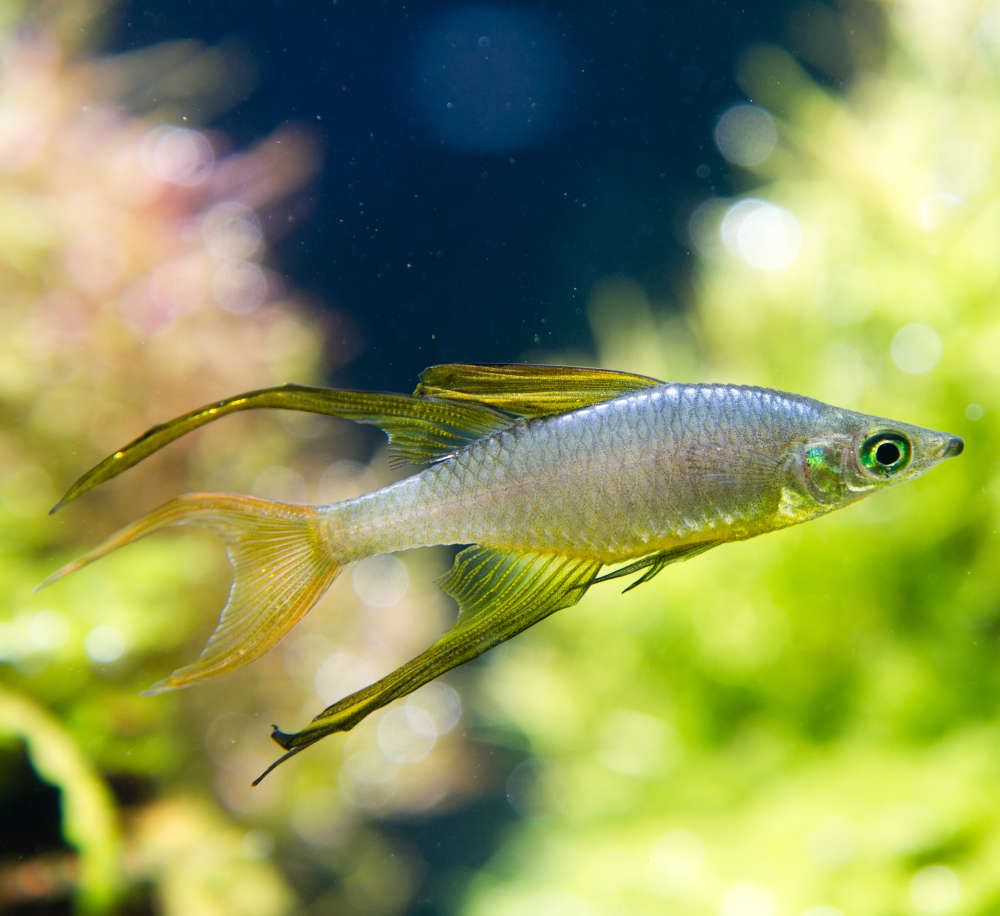
- Other Common Names: Werneri
- Average Size: Up to 5 cm (2 in), commonly 3-4 cm (1.2-1.6 in)
- Average Lifespan: Up to 5 years in captivity, unknown in the wild
- Tank Level: Top-dwellers
- Temperament: Peaceful
- Diet: Omnivorous
- Tank Mates: Own group, similar-sized peaceful fish and invertebrates
- Minimum Tank Size: 20 gallons for a small school
The threadfin rainbowfish is a small, slim fish. It has a silver body with iridescent blue on top and orange underneath.
The male fish has faint stripes along their back with a fan-shaped first dorsal fin that has various colors like red, black, yellow, red, or orange.
Its second dorsal fin, pelvic fins, and anal fins are longer and are either black or dark yellow. The tail is either blue or clear with red tips. The colors of male fish can change depending on their health, food, and the light they’re in.
Female fish are honey-colored with a bit of green and see-through fins. Young or stressed fish won’t look as vibrant as calm, grown-up ones. Rainbowfish from different rivers might have different colors and fin shapes.
The fish gets its name from its thread-like, elongated dorsal fin. This feature sets it apart from other rainbowfish species.
2. Australian Rainbowfish (Melanotaenia fluviatilis)
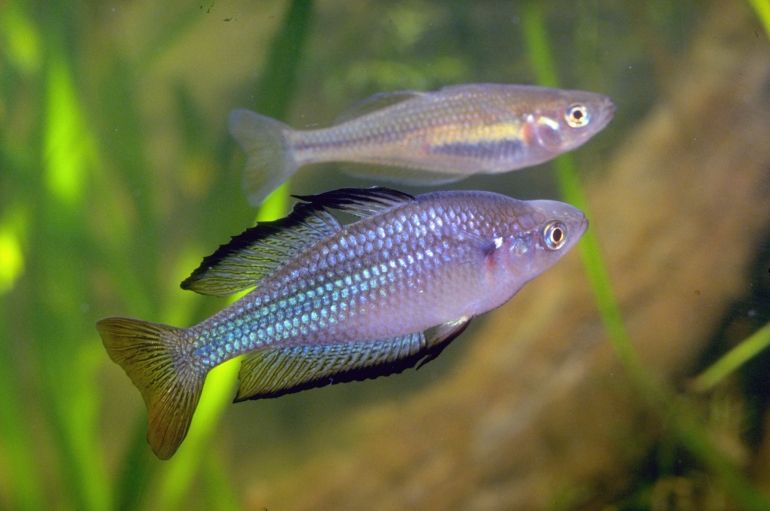
- Other Common Names: Rainbow-fish, pink-eared rainbowfish, pink-ear, murray-darling sunfish, Murray river sunfish, Murray river rainbowfish, crimson-spotted rainbowfish, crimson-spotted jewelfish
- Average Size: Up to 10 cm (4 in)
- Average Lifespan: Up to 5-8 years
- Tank Level: Top and middle-dwellers
- Temperament: Peaceful
- Diet: Omnivorous
- Tank Mates: Own group, playful but peaceful species of similar size
- Minimum Tank Size: 40 gallons for 5-6
The Australian rainbowfish has a wide body with a soft rainbow of blue, green, yellow, or silver on its body and greenish scales.
Its fins may display yellow, red, or orange hues. A blue stripe stretches from its snout to the caudal fin.
Male fish develop a vibrant orange stripe on its posterior and red spots on the dorsal, anal, and caudal fins before spawning. It is also larger and more colorful than the females.
Male fish become more attractive and colorful as they age. This helps to enchant females for mating purposes.
3. Turquoise Rainbowfish (Melanotaenia lacustris)
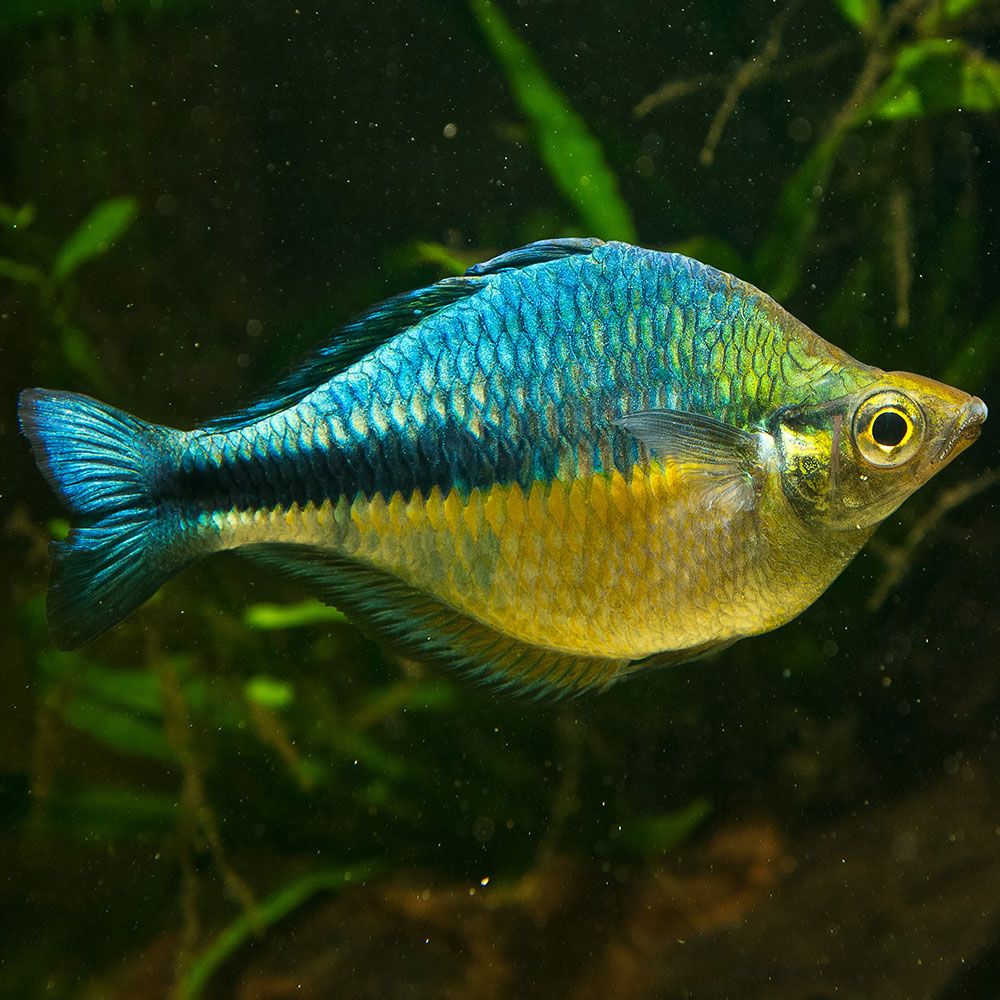
- Other Common Names: Lake Kutubu rainbowfish, blue rainbowfish
- Average Size: About 10 cm (4 in) in captivity, up to 12 cm (4.8 in) in the wild
- Average Lifespan: Up to 5-8 years
- Tank Level: Middle to top dwellers
- Temperament: Peaceful, aggressive toward incompatible tank mates
- Diet: Omnivorous
- Tank Mates: Own group, other peaceful fish of similar size and invertebrates
- Minimum Tank Size: 30 gallons for one
The turquoise rainbow fish features a wide, blue body that deepens with age, along with a distinctive sharp first dorsal fin, rounded second dorsal and anal fins.
Its head is triangular, with large eyes and a small mouth. The pectoral and pelvic fins are transparent and delicate.
The male fish is more colorful and larger, with an arched back and pointed anal fin. In contrast, the female is paler and slimmer. The male fish can get aggressive at times, while the female fish is calmer.
This species displays color changes throughout the day, with its skin responding to its mood through chromatophores and iridophores.
4. Boesemani Rainbowfish (Melanotaenia boesemani)
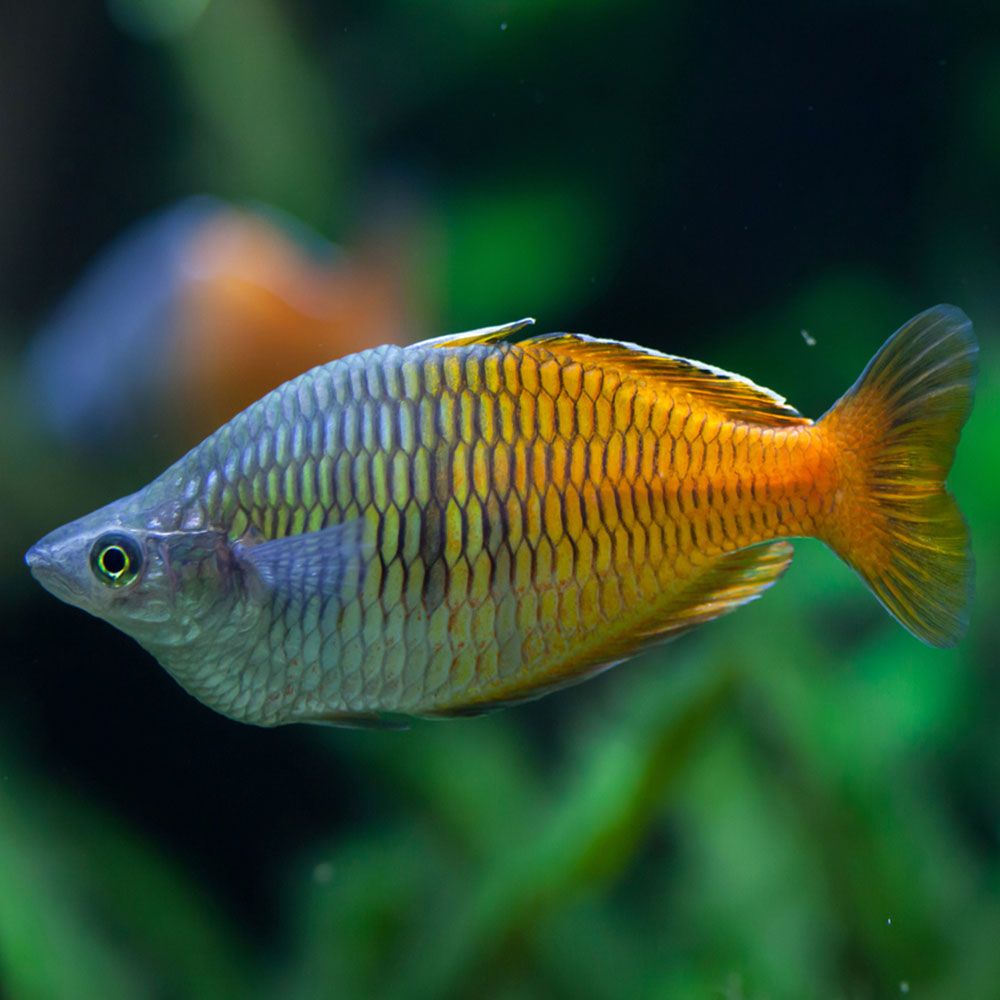
- Other Common Names: Boesemani, Boeseman’s rainbowfish
- Average Size: Up to 10 cm (4 in) for males, up to 8 cm (3 in) for females
- Average Lifespan: Up to 5-8 years
- Tank Level: Middle-dwellers
- Temperament: Generally peaceful, may turn aggressive around other aggressive or shy species
- Diet: Omnivorous
- Tank Mates: Own group, peaceful fish of similar size and invertebrates
- Minimum Tank Size: 30 gallons for 6
The Bosemani rainbowfish has a flat and oval body with larger eyes and a smaller mouth. Its small tail fin protrudes out, while other fins are compact.
It’s vibrantly colored with warm tones (reds, oranges, yellows) at the rear and cooler tones (blues, purples, greens) at the front.
A bluish-grey scale band with a hint of purple runs along the front body. The color transitions to orange-red with yellow towards the rear, resulting in green or blackish stripes.
Males have larger, deeper bodies and typically display more vibrant colors. Females are smaller and have a slightly faded appearance with silver fins that may appear opaque or yellowish.
Boeseman’s rainbowfish boasts six changing colors — red, orange, yellow, blue, purple, and green — that change depending on their mood and surroundings.
5. Madagascar Rainbowfish (Bedotia madagascariensis)

- Other Common Names: Madagascan rainbowfish, zona, red-tailed silverside
- Average Size: Usually up to 8-8.6 cm (3.2-3.4 in), max: 10 cm (4 in)
- Average Lifespan: Usually up to 5 years, max 11 years
- Tank Level: Upper or middle dwellers
- Temperament: Peaceful
Diet: Omnivorous - Tank Mates: Own group, peaceful, non-fin nipping, bottom-dwelling, community species
- Minimum Tank Size: 30 gallons for a school of 5-6 fish
The body of the Madagascar rainbowfish is pale yellowish-brown with a subtle blue sheen. It has a prominent dark blue band running along its body and a fainter, shorter band below it.
Adult males display more intricate pigmentation in their unpaired fins and are overall more colorful than females.
Females have fuller bodies, particularly when they are gravid (carrying eggs). Various regional color variations exist.
This rainbowfish earned their name from their place of origin, which is the island of Madagascar off the east coast of Africa.
6. Forktail Rainbowfish (Pseudomugil furcatus)
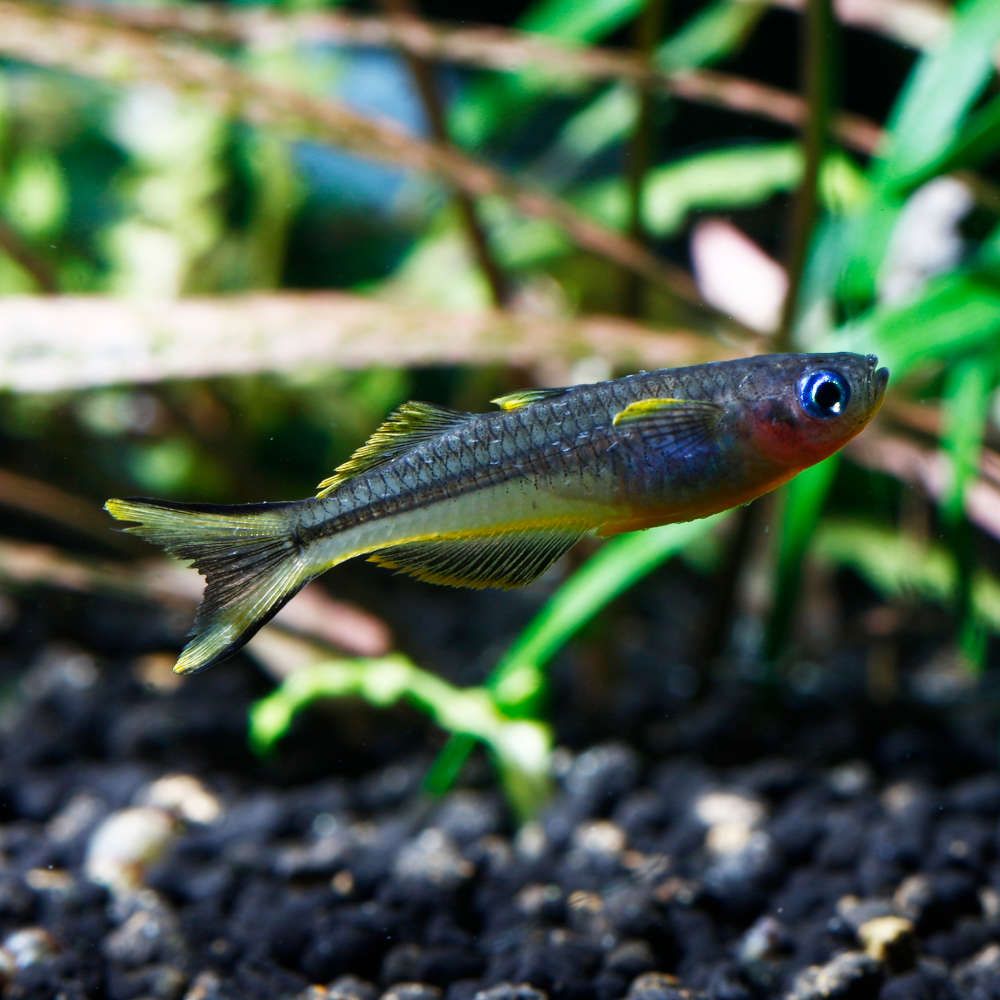
- Other Common Names: Forktail blue eye
- Average Size: Up to 5 cm (2 in)
- Average Lifespan: Up to 3 years
- Tank Level: Middle-dwellers
- Temperament: Peaceful, aggressive during spawning
- Diet: Omnivorous
- Tank Mates: Own school, other peaceful tank mates that inhabit other levels
- Minimum Tank Size: 30 gallons for a small group
The forktail rainbowfish has a silvery, torpedo-shaped body with a rounded head and an upward-facing mouth with blue eyes.
You will see bright yellow stripes on the top and bottom during breeding. It has upturned, wing-like pectoral fins and bright yellow dorsal fins in the breeding season.
It features a small spiny dorsal fin and a larger squared-off soft dorsal fin that extends toward the tail. The anal fin has a similar shape.
The females appear paler and lack the sharp dorsal and pectoral fins seen in males. However, they have yellow fins and distinct outlines on both the top and bottom of their bodies.
7. Neon Rainbowfish (Melanotaenia praecox)
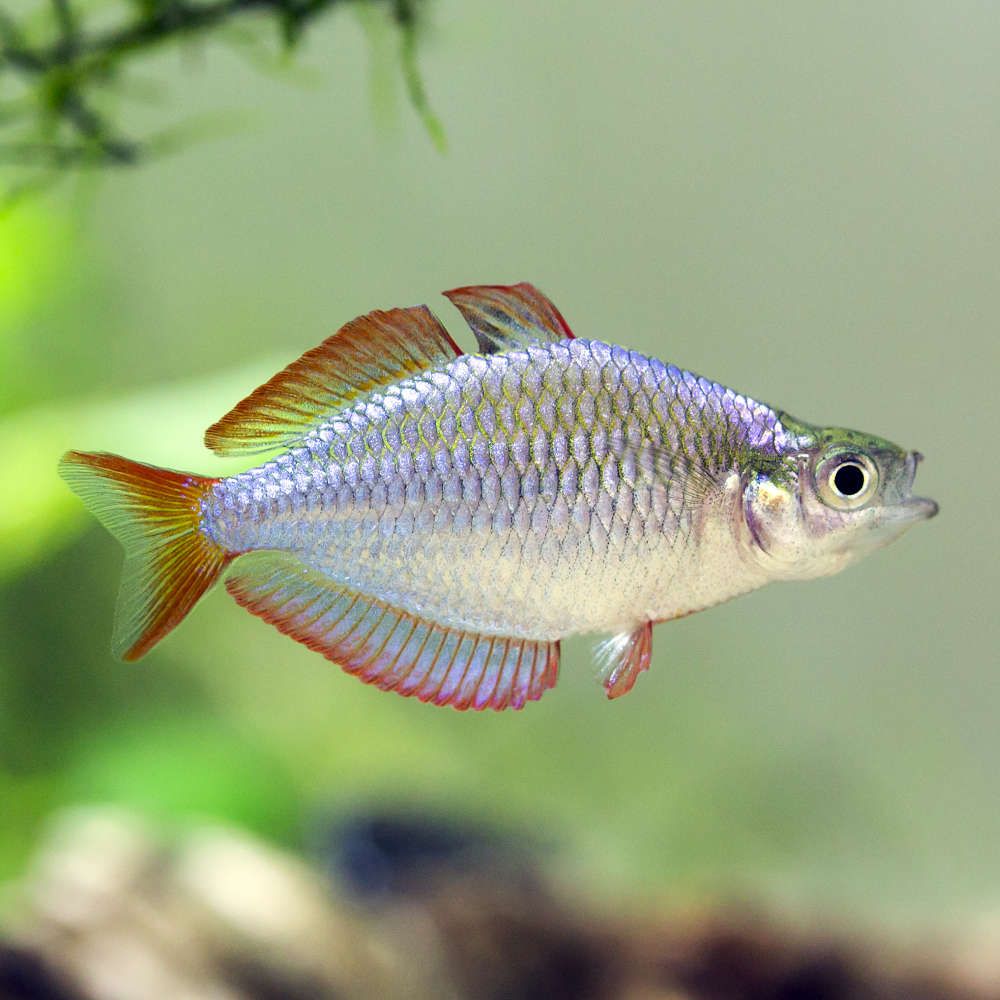
- Other Common Names: Diamond rainbowfish, Praecox rainbowfish, dwarf neon rainbowfish, peacock rainbowfish, dwarf rainbowfish.
- Average Size: Up to 7.6 cm (3 in)
- Average Lifespan: Up to 3-5 years
- Tank Level: Top to middle-level dwellers
- Temperament: Peaceful, active community fish
- Diet: Omnivorous
- Tank Mates: Own school, peaceful and semi-aggressive fish of similar size
- Minimum Tank Size: 30 gallons for a group
The neon rainbowfish has an elongated, slightly flattened body. As it grows, especially the male fish, its body shape becomes more deep-bodied.
The body base is greyish-pink, turning bright blue or greenish-blue in the right light. It has two closely positioned dorsal fins, with the first being smaller.
The male also has red fins, while the female has yellow ones.
This is one of the newest rainbow fish that entered the trade around the 1980s.
8. Celebes Rainbowfish (Marosatherina ladigesi)
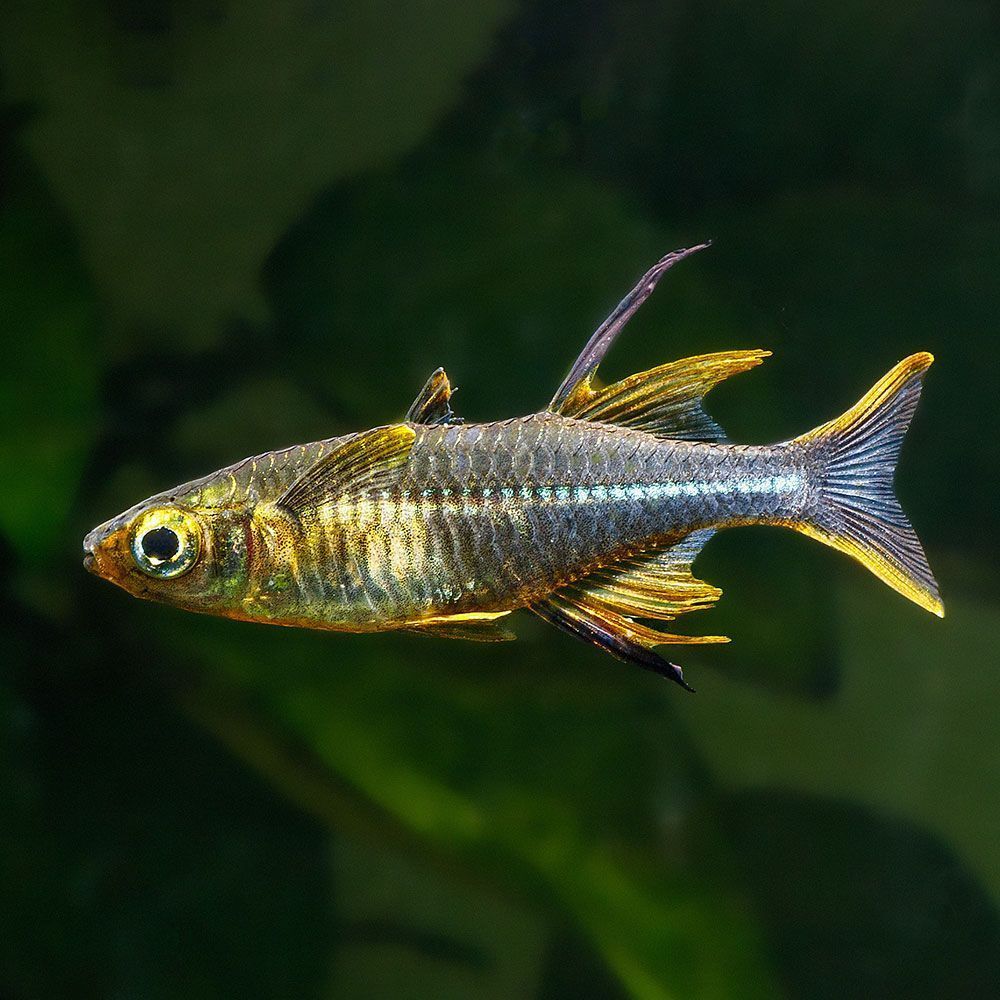
- Other Common Names: Celebes rainbow, Celebes sailfin, Celebes sailfish
- Average Size: Up to 8 cm (3.2in)
- Average Lifespan: Usually 3-5 years, max 8 years
- Tank Level: Middle-level dweller
- Temperament: Peaceful, very active
- Diet: Omnivorous
- Tank Mates: Own group, other peaceful species of similar size
- Minimum Tank Size: 20 gallons for one
The Celebes rainbowfish is primarily silvery-white with scattered yellow specks and a neon blue-green stripe on its side. Its pectoral fins are whitish, while the other fins are yellow with black accents.
It has a slender body with a small mouth, large eyes, unique sail-like dorsal fin filaments, symmetrical forked caudal fins, and smaller pectoral fins starting at the gill base. The fish’s back is transparent, with translucent scales, revealing organ sacs and bones.
Males are larger with intense colors and long black dorsal and ventral fins, while females are smaller, paler, lack elongated fins and have a rounder shape.
Varieties of this fish come in various colors, including red, blue, purple, green, yellow, and orange.
Male celebes rainbowfish show their brightest colors when surrounded by other males. So it’s best to keep them in groups of at least six to eight individuals.
9. Red Rainbowfish (Glossolepis incisus)
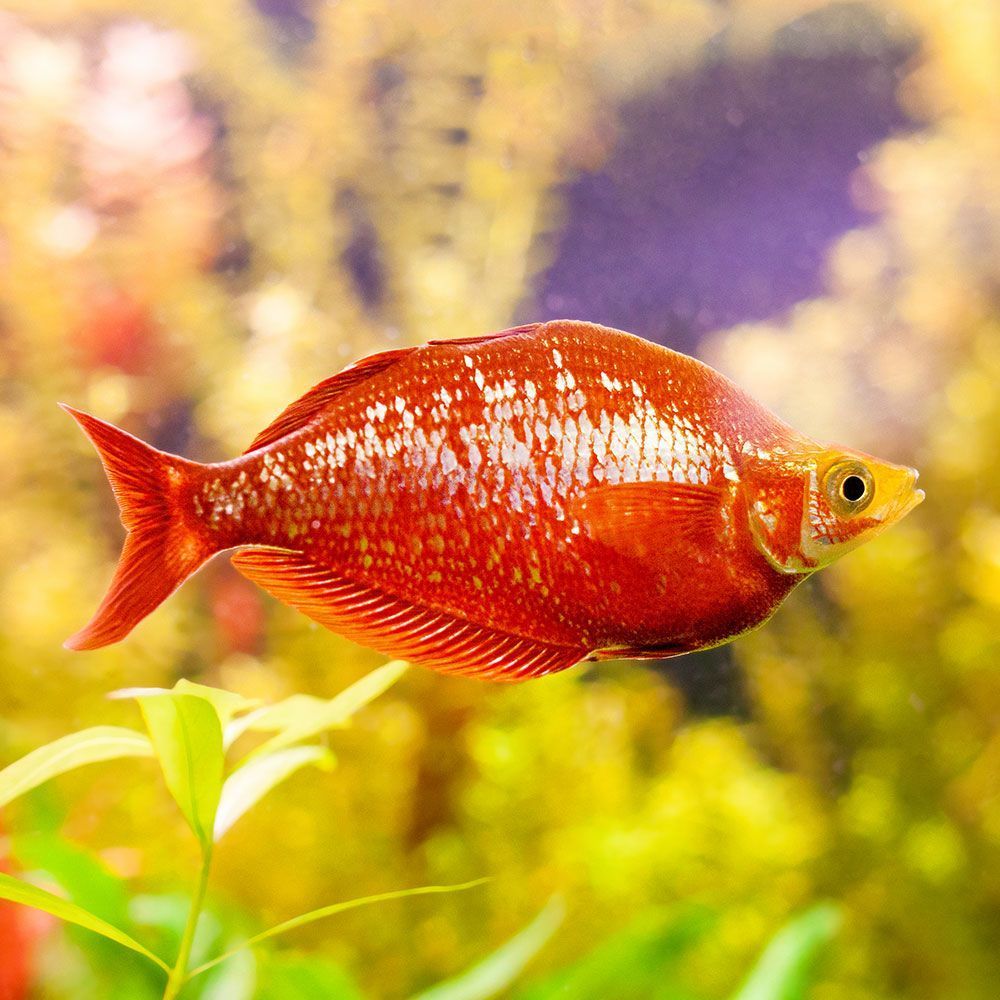
- Other Common Names: Salmon red rainbowfish, red rainbow
- Average Size: Up to 15 cm (5.9 in)
- Average Lifespan: Up to 6-8 years
- Tank Level: Top-dweller
- Temperament: Very peaceful with rapid movements. Can bully overly shy species
- Diet: Omnivorous
- Tank Mates: Own school, similarly sized fish and invertebrates
- Minimum Tank Size: 150 Gallons
The salmon red rainbowfish is a long, slender fish with a highly arched back and narrow head in mature males. It has large eyes, a deeply forked mouth, and two dorsal fins.
Mature males display a brilliant blood-red body with silver scales, while females and young males are uniformly dull olive-brown with clear gray fins.
These fish reveal their brilliant red colors during competition with other males seeking female attention.
10. Kamaka Rainbowfish (Melanotaenia kamaka)
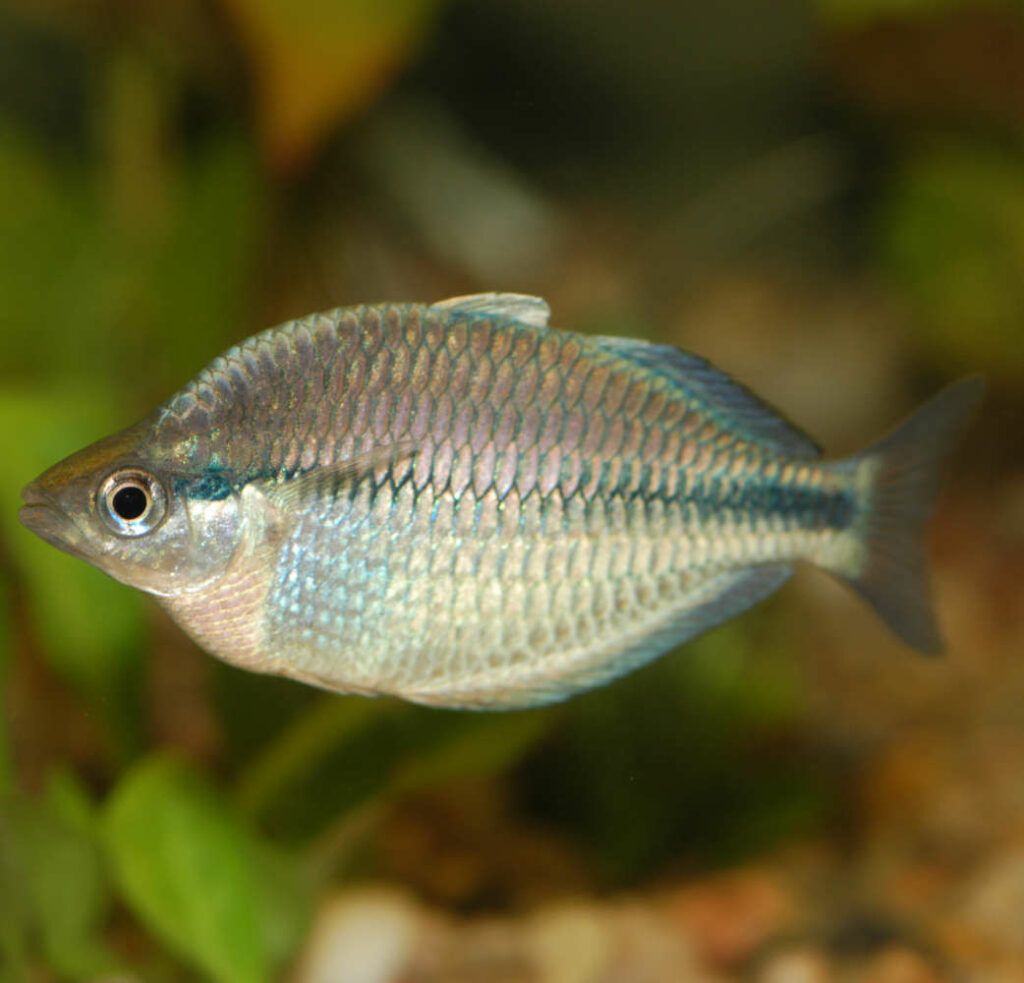
- Average Size: Up to 14 cm (5.5 in)
- Average Lifespan: Up to 5 years
- Tank Level: Middle-dwellers
- Temperament: Peaceful, schooling species
- Diet: Omnivorous
- Tank Mates: Own school, other rainbowfish, and similar or smaller-sized peaceful fish
- Minimum Tank Size: 55 gallons for a school of 6
The male kamaka rainbows have a silver-blue upper body with silver flakes and silver-white lower parts, forming a striking blue-to-black mid-lateral stripe.
They have a dark patch near the eye. Their first dorsal, pelvic, and anal fins are whitish, while the second dorsal and caudal fins have a bluish tint, and the pectoral fins are translucent.
Females have a more diffuse and translucent fin coloration with a broad mid-lateral stripe from the eye to the caudal fin base.
Males are larger and display more vibrant colors than females, often with extended dorsal and anal fins.
The distinguishing mid-lateral stripe in males is thicker compared to the more slender one in females. They also get deeper-bodied as they age.
11. Spotted Blue Eye Rainbowfish (Pseudomugil gertrudae)
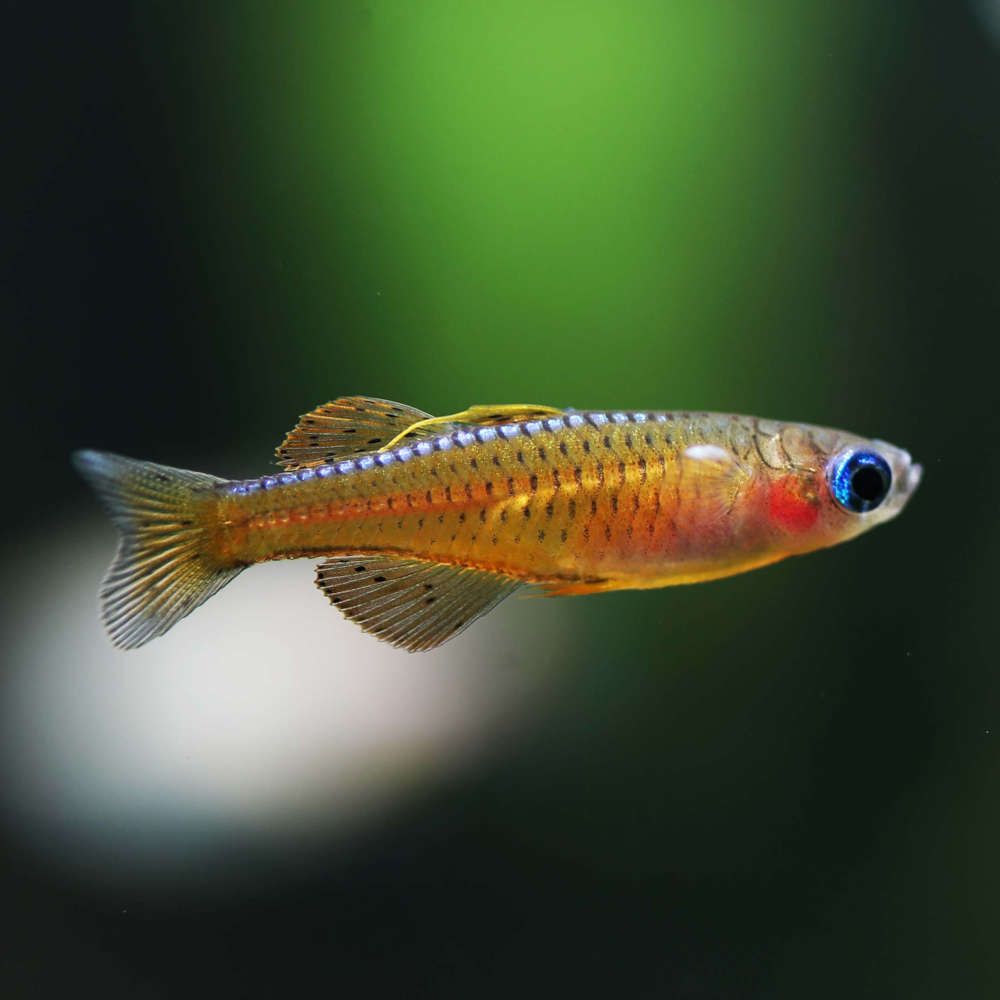
- Other Common Names: Northern blue-eye, Gertrude’s blue-eye
- Average Size: Up to 4 cm (1.6 in)
- Average Lifespan: Up to 3-5 years
- Tank Level: Middle dweller
- Temperament: Peaceful, active and social
- Diet: Omnivorous
- Tank Mates: Own school, peaceful community fish
- Minimum Tank Size: 10 gallons for 6-8
The spotted blue-eye rainbowfish has a sleek, semi-transparent body with a blueish-silver tone and hints of golden yellow.
It has bright yellow, orange, or orangey-red pectoral fin tips and white-bordered anal, dorsal, and tail fins with oblong or round dark spots. There’s a striking latticework pattern on its body with several rows of black-bordered scales and a continuous mid-lateral stripe.
Males have larger fins, elongated filaments on the first dorsal and pelvic fins, and more vivid colors and spots. Females have dull colors and smaller fins.
This fish is named after Dr. Hugo Merton’s wife, who was a German naturalist visiting Indonesia’s Aru Islands in 1907.
12. Millennium Rainbowfish (Glossolepis pseudoincisus)
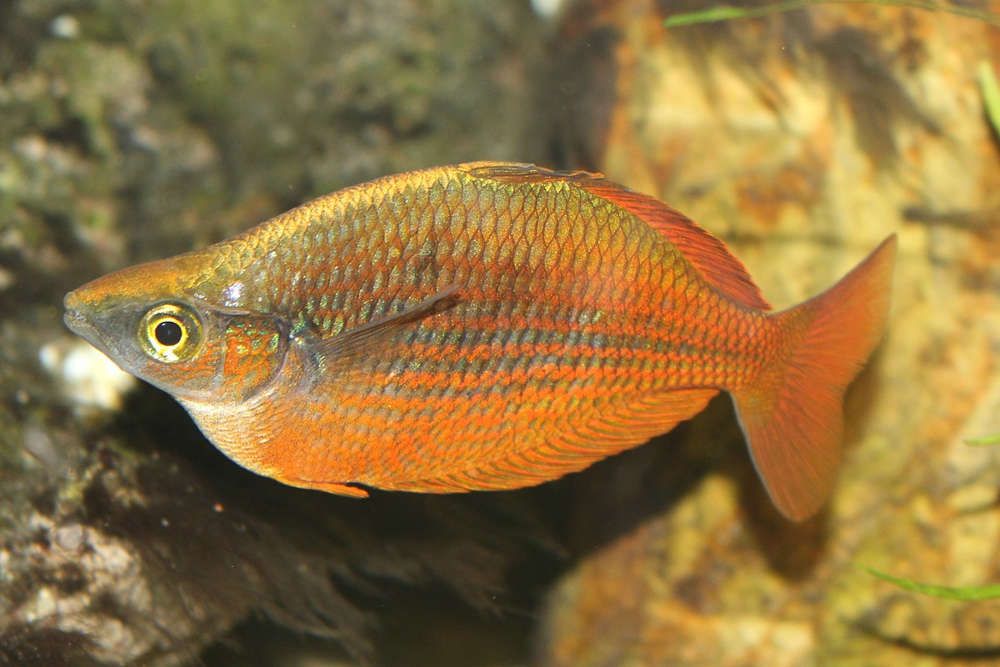
- Other Common Names: Tami river rainbowfish
- Average Size: Up to 12.7 cm (5 in)
- Average Lifespan: Up to 5-8 years
- Tank Level: middle dwellers
- Temperament: Peaceful, highly active
- Diet: Omnivorous
- Tank Mates: Own school, peaceful species of similar size
- Minimum Tank Size: 65 gallons for 5-6
This rainbowfish has a slender body and a laterally compressed body. It develops a vivid crimson body color at around three months of age, which deepens into intense blood-red. It has an arched back, a narrow head, and large eyes with silver scales.
Displaying males can activate a bright neon orange stripe as a breeding signal to females. Females and young males are silvery brown, with some females displaying faint vertical stripes around the middle of their bodies.
To witness the males of this rainbowfish flaunting their brightest colors, consider slightly cooler temperatures of around 70°F (21°C).
13. Parkinsoni Rainbowfish (Melanotaenia parkinsoni)
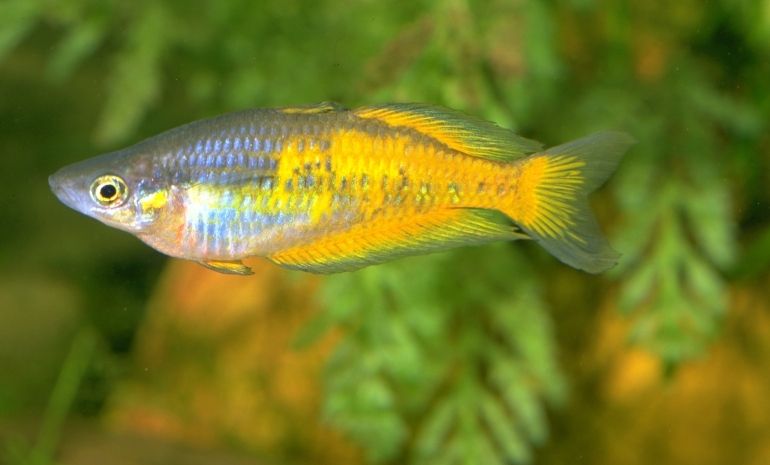
- Other Common Names: Parkinson’s rainbowfish
- Average Size: Up to 12.7 cm (5 in) in captivity, 15 cm (5.9 in) in the wild
- Average Lifespan: Up to 5-8 years
- Tank Level: Middle dweller
- Temperament: Peaceful schooling fish
- Diet: Omnivorous
- Tank Mates: Own school, larger, playful but peaceful fish and invertebrates
- Minimum Tank Size: 40 gallons for 6
The Parkinson’s rainbowfish has a large, slender body that deepens with age, and its base color is lavender with reflective silvery-blue scales.
Mature males have bright orange fins with a bold black outline and unique orange markings that vary between individuals. Females have a muted coloration compared to males, with no orange markings.
Male Parkinson’s Rainbowfish are slightly larger, deeper-bodied, and exhibit more intense colors than females.
The Parkinson’s rainbowfish was named after Brian Parkinson, who often accompanied Ichthyologist Gerald R. Allen in his expeditions to New Guinea.
A word from FishInAquarium
No matter which rainbowfish you choose from the list, they will surely bring you a lot of delight with their captivating colors and lively personality. They add life and visual appeal to your aquarium while promoting a harmonious community.
These small, low-maintenance finny buddies fish adapt well to different conditions and are an excellent choice for beginners. Some of them also offer a rewarding breeding experience with intriguing courtship behaviors.
If you’ve enjoyed learning about these stunning species, don’t forget to share this article with fellow aquarists to spread the joy of rainbowfish in home aquariums. But if you have any questions, drop us an email, and we will take it up from there.
Happy Fishkeeping!

